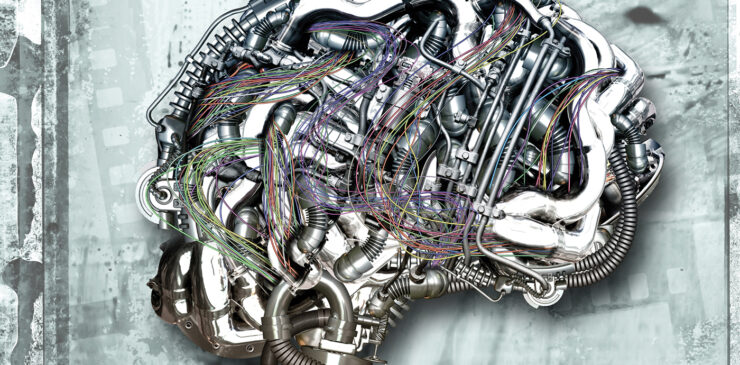Let’s begin with some background. In the intricate web of our nervous system, neurons communicate to produce our movements, emotions and bodily functions. This network gets laid out and fined tuned during development where neurons find and connect to their appropriate targets. Once this is achieved during childhood the neuronal network is relatively stable. However, adaptations in the connectivity of the nervous system are essential to be able to respond to changes in the environment or our body, e.g., when we have to learn a new task or when we are injured. The process of the brain and spinal cord being able to change its connectivity to adapt its functional abilities, is termed neuroplasticity.
 Following an SCI, the brain and spinal cord can undergo plastic changes, although these changes might not always be intentional or advantageous. Neuroplasticity plays a role in both the positive effects of rehabilitative training and the development of secondary complications like neuropathic pain, spasticity, depression, and autonomic dysreflexia. Researchers are delving into the intricate workings of these plastic changes within the brain and spinal cord after an SCI, seeking to decipher how they impact functional abilities and exploring methods to harness the m for better outcomes. This is why in recent news, you may have heard of this hot new area of research called neuromodulation and its potential results concerning SCI.
Following an SCI, the brain and spinal cord can undergo plastic changes, although these changes might not always be intentional or advantageous. Neuroplasticity plays a role in both the positive effects of rehabilitative training and the development of secondary complications like neuropathic pain, spasticity, depression, and autonomic dysreflexia. Researchers are delving into the intricate workings of these plastic changes within the brain and spinal cord after an SCI, seeking to decipher how they impact functional abilities and exploring methods to harness the m for better outcomes. This is why in recent news, you may have heard of this hot new area of research called neuromodulation and its potential results concerning SCI.
Promoting neuroplasticity will be necessary in successful future treatment approaches. Whether it is through intense rehabilitation after SCI to take advantage of spared circuitry, or by driving task-specific changes after the delivery of treatments that induce axon growth or regeneration, the connections within the nervous system will need to re-arrange to maximize function.
There are several ongoing clinical research efforts which leverage neuroplasticity for functional gain.
These include functional exercise / activity-based therapy (ABT) in combination with:
![]()
Acute Intermittent hypoxia (AIH)
AIH is an emerging rehabilitation technique that capitalizes on the body’s response to low oxygen levels. By exposing individuals to controlled periods of low oxygen followed by normal air breathing, AIH triggers a genetic response that promotes axon growth and plasticity in neurons. There has been increasing evidence for AIH as a safe and efficacious method to improve motor function in people with SCI in combination with intense rehabilitation training.
![]()
Stem Cell Therapies
Stem cell therapies have garnered significant attention as a potential catalyst for neural system adaptations following SCI. Stem cell transplantations can replace lost neurons, create a growth-supportive matrix for axon regeneration, produce growth and trophic factors that facilitate axon regrowth, and shield surrounding tissues from secondary injury cascades. This approach holds the potential to restore lost connections and functions, giving individuals a renewed chance at improved quality of life.
![]()
Neural Modulation
Epidural spinal stimulation (ESS) and transcutaneous spinal stimulation (TSS) have become one of the more recent advancements to treat SCI as it has demonstrated the ability to restore some functional abilities even in individuals with chronic motor and sensory complete injuries. The difference between ESS and TSS is the former is an invasive procedure as the electrode needs to be placed in the epidural space of the skin via surgery, while the latter produces stimulation by having the electrode placed above the skin. By activating these stimulators, the signals that were previously insufficient to engage muscles become powerful enough to initiate movement. When coupled with intensive rehabilitation training, it can lead to remarkable restoration of function. Strikingly, some individuals even report lasting improvements after the stimulators are turned off.
![]()
Brain Computer Interfaces (BCI)
BCIs are ushering in a new era of interaction between the human brain and external devices. By reading and interpreting neural activity, BCIs enable individuals to control external devices with their thoughts. This emerging tool holds potential for people with SCI, allowing them to interact with their environment in new and exciting ways. To succeed, both the BCI device and the user need to undergo a learning process. This blend of neural plasticity and technological innovation offers hope for restoring independence and functionality.
As our understanding of neuroplasticity deepens, a powerful truth emerges: the future of treating SCI lies in the fusion of cutting-edge strategies and personalized approaches. By harnessing the potential of neuroplasticity and combining it with task-specific training, clinicians and researchers are pushing the boundaries of functional recovery.It is extremely important to those with a SCI to learn more on how one’s body will function post-injury.
The North American Spinal Cord Injury Consortium (NASCIC) has created a course that presents the information necessary to understand the complexities of an SCI. To learn more about current neuroplasticity research and how it affects people living with an SCI, as well as to explore the other modules NASCIC provides, register for the SCI Research Advocacy Course. https://nascic.org/courses/nascic-community-engagement-program-cep/.






